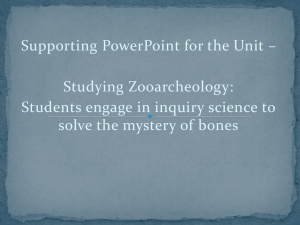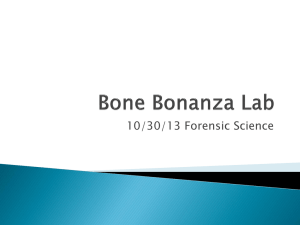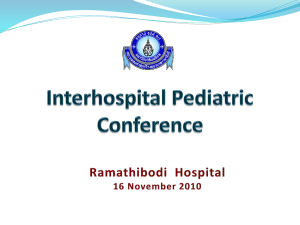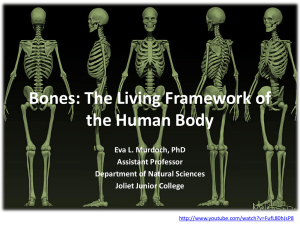Charlie R Campion
advertisement
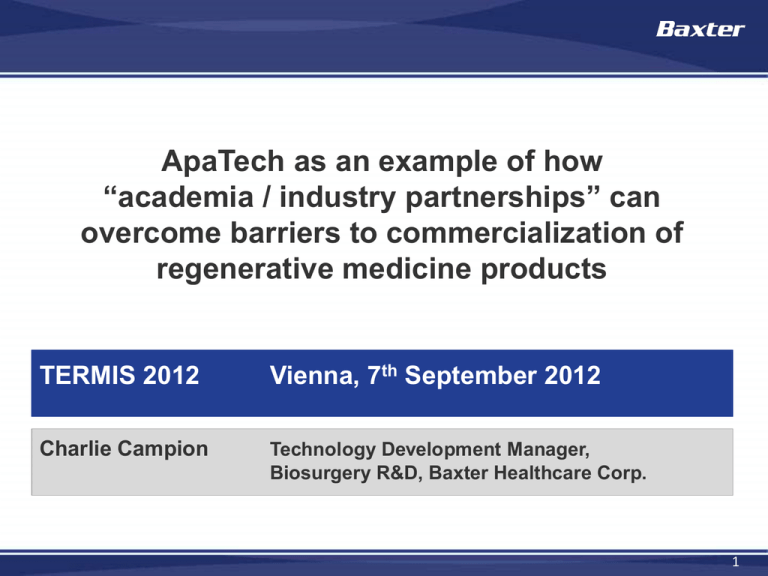
ApaTech as an example of how “academia / industry partnerships” can overcome barriers to commercialization of regenerative medicine products TERMIS 2012 Vienna, 7th September 2012 Charlie Campion Technology Development Manager, Biosurgery R&D, Baxter Healthcare Corp. 1 Since the acquisition in 2010, ApaTech products have formed part of the Biosurgery portfolio at Baxter ACTIFUSE GRANULES/ MICROGRANULES ACTIFUSE ABX ACTIFUSE EZ-PREP ACTIFUSE SHAPE ACTIFUSE MIS ApaTech specializes in developing and manufacturing synthetic bone repair products for the global orthobiologics market 2 There are many challenges which new companies face when entering the healthcare market Development Funding Regulatory Complexity Manufacturing Capacity Barriers to Market Entry Time to Product Launch Surgeon Advocacy Sales & Distribution 3 Although not the only success factor, academic partnerships have been fundamental to growth at ApaTech Portfolio development 5 new products in 5 years Award-winning sales growth 180% yr/yr 2006-2009 Research data Publications Rapid growth Investor confidence £32.5M of funding in 7yrs (3 rounds) Capacity expansion 1L : 1600L upscaling factor in 7 yrs Prestige Process experts 4 ApaTech has academic roots: ApaTech was founded in 2001 as a spin-out from the IRC, Queen Mary, UoL Surface Science Nanotechnology Ageing Materials Processing Humanities Biomedical Materials Earth, Planetary, Space and Astronomy In the 1990’s the UK government funded specialised centres of research to promote the growth of UK research and manufacturing 5 IRC Biomedical Materials Formed in 1991 Professor Bill Bonfield £10 million funding Multi-centre approach: Institute of Orthopaedics at UCL There was an established pedigree for bone research within the centre which ApaTech were able to leverage in the early days of commercialisation 6 University of London – IRC in Biomedical Materials Bone functions as a mineral reservoir for the body Porous bone graft substitutes comprised of thermally transformed Bovine and Coralline Hydroxyapatite were already in clinical use for bone grafting Research Questions: Do low-level ionic substitutions play a role in the biology of bone repair? What is the role of a bone graft substitute’s structure in the biology of bone repair? A multi-disciplinary approach was applied to the common research goal of the IRC : how can we develop superior synthetic bone grafts? 7 7 Do low-level ionic substitutions play a role in the biology of bone repair? Professor Iain Gibson BSc (Hons), PhD − Ionic substitutions − Metabolic role of minerals in bone − Further increase in cellular response Professor Gibson now has a chair at University of Aberdeen where his research is based on guiding cell behaviour during tissue repair and wound healing, using physico-chemical guidance cues 8 What is the role of a bone graft substitute’s structure in the biology of bone repair? Dr Karin Hing CEng, PhD, BSc, MIMMM, FRMS − Foaming ceramics − Porous HA − Increased cellular response Dr Hings’s research group at QM is now engaged in physico-chemical and hierarchical 3-D structural characterisation of bone grafts, the study of protein interactions, cell response and chemotaxis 9 ApaTech continued to expand it’s network of academic partners throughout the UK & across the Globe 10 ApaTech used a variety of mechanisms to partner with academic research centres Consultancy Contracts PhD Studentships Undergraduate Project Mentoring MSC student Funding Academic Research Centre Contract Services Student Award Sponsorship IP Purchase agreements Symposia Sponsorship 11 ApaTech continue to leverage subject matter expertise in Academia to get products to market Portfolio development 5 new products in 5 years Proportion of regulatory non-clinical studies * Reg. Data 33% 67% * Data for the period between 1st round funding up to Baxter Healthcare acquisition (2001 – 2010) Contract Research Organisation Academic Research Centre 12 ApaTech continue to leverage subject matter expertise in Academia to develop product pipeline Portfolio development 5 new products in 5 years Reg. Data Proportion of patents granted or pending by origin * 33% 67% * Data for the period between 1st round funding up to Baxter Healthcare acquisition (2001 – 2010) ApaTech Academic Research Centre 13 ApaTech continue to use their academic pedigree to provide robust mechanistic data to support sales Award-winning sales growth 200% yr/yr 2007-2009 Proportion of supporting publications (1st author) * 3% Publications 97% * Data for the period between 1st round funding up to Baxter Healthcare acquisition (2001 – 2010) ApaTech Employee Academia Based Researcher 14 Summary ApaTech was founded in Academia and was able to leverage its pedigree to keep investors on-board. ApaTech continued to partner with Global academic centres to reduce time-tomarket whilst building a robust scientific story around the commercialised technology. The way forward: ApaTech have demonstrated there are a number of mechanisms by which Industry can interact with Academia in order to minimise the impact of barriers to market, whilst developing the next generation of scientific advocates for the commercialised technology. 15 Acknowledgements − Professor Heinz Redl for my invitation − The co-founders of ApaTech and the investors who believed in them − All Academic research centres ApaTech have collaborated with since commercialisation began in 1999 16



